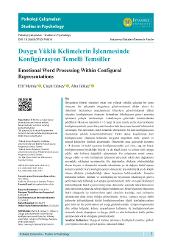| dc.contributor.author | Memiş, Elif | |
| dc.contributor.author | Güney, Çiçek | |
| dc.contributor.author | Gökçe, Ahu | |
| dc.date.accessioned | 2021-07-24T18:24:23Z | |
| dc.date.available | 2021-07-24T18:24:23Z | |
| dc.date.issued | 2020 | |
| dc.identifier.issn | 1304-4680 | en_US |
| dc.identifier.uri | https://hdl.handle.net/20.500.12469/4088 | |
| dc.identifier.uri | https://search.trdizin.gov.tr/yayin/detay/357944 | |
| dc.description.abstract | The impact of emotions on cognitive processes has been studied intensively in the last years. The aim of the present study is to investigate the relationship between visuospatial attention processes and emotions. Visuospatial attention processes were investigated by using a localization task which required processing of the words that formed the configuration. In the localization task, participants were asked to indicate the position of the target word which matched the color of the fixation cross ("+") by pressing the relevant keyboard button. In each trial, four words in different colors were positioned to form a square configuration. In different experimental conditions, words that formed the configuration varied in their valence (neutral, positive and negative words). The intertrial transitions (trial 1 -> trial 2) consisted of changes in the target's location within the configuration (e.g. top right corner), size of configuration (big/small square) and type of word (emotional/neutral). The main goal of the present study is to investigate the interaction between the processing of emotional and neutral words and certain variables. The variables were the size of the attended area and localizing the target word that was repeated or changed across trials. By changing the size of the configuration (small / big sized square) across trials, the size of the attended area was determined. The results revealed that changes in word valence and size of the configuration led to differences in the localization task performance. It was found that neutral and negative words led to target location repetition cost. Different location targets were processed faster suggesting that word processing was easier. Additionally, bigger, compared to smaller configurations, led to better performance only when emotional words were used. Overall findings of the present study suggest that configural representations are formed automatically by using the word stimuli, and they influence the processing of emotional and neutral words differently. | en_US |
| dc.language.iso | eng | en_US |
| dc.publisher | ISTANBUL UNIV | en_US |
| dc.rights | info:eu-repo/semantics/openAccess | en_US |
| dc.subject | Emotional word processing | en_US |
| dc.subject | configural representations | en_US |
| dc.subject | global/local processing | en_US |
| dc.subject | visual search | en_US |
| dc.subject | spatial attention | en_US |
| dc.title | Emotional Word Processing Within Configural Representations | en_US |
| dc.type | article | en_US |
| dc.identifier.startpage | 79 | en_US |
| dc.identifier.endpage | 104 | en_US |
| dc.relation.journal | STUDIES IN PSYCHOLOGY-PSIKOLOJI CALISMALARI DERGISI | en_US |
| dc.identifier.issue | 1 | en_US |
| dc.identifier.volume | 40 | en_US |
| dc.identifier.wos | WOS:000533602900004 | en_US |
| dc.identifier.doi | 10.26650/SP2019-0014 | en_US |
| dc.institutionauthor | Gökçe, Ahu | en_US |
| dc.relation.publicationcategory | Makale - Uluslararası Hakemli Dergi - Kurum Öğretim Elemanı | en_US |
| dc.identifier.trdizinid | 357944 | en_US |
















